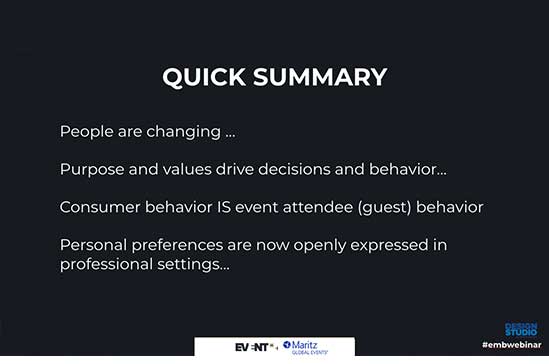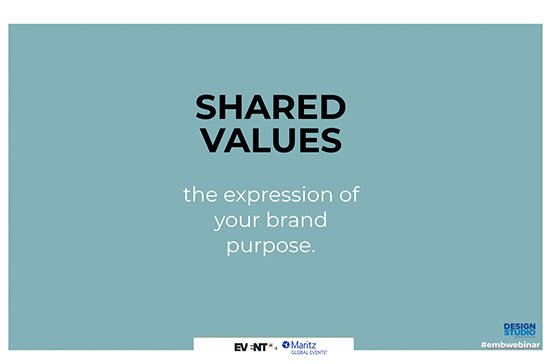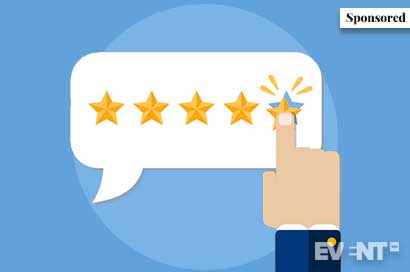This is a sponsored post by Maritz Global Events. More information about Event Manager Blog’s sponsored posts.
Just a few years ago, event experiences were the cure-all solution that event planners were looking for. The oft-given advice was to offer an experience because we all remember how experiences made us feel.
But then they became too common, as everyone was trying to take part in the experience-economy. Event planners wondered why their experiences weren’t providing the ROI that the event experts were claiming they would.
We sat down with Greg Bogue and Tim Simpson from Maritz Global Events’ Design Studio™ after one of the most successful webinars we have ever run (available on demand here) and asked them to share more on how experiences are changing.


We started talking about experiences about ten years ago. Since then, there has been an incredible flood of experiences into events. And why not? After all, guests are expecting them. However, experiences are hollow without a larger context to make them meaningful. Greg pointed out event experiences can feel a lot like cable TV. There are so many options and yet there’s nothing to watch.
The reason so many event planners turned to experiences was to differentiate their offerings from others, to make the events memorable. Today, experiences are still a valuable part of event design but they must have meaning, otherwise the event will fall victim to the oversaturation of events.
Bogue cautioned that event planners should look to avoid the hollowness of experiences and find ways to make events more meaningful. Here is what he and Tim had to say about how event planners can do that:
Audience Understanding Makes Experience Design Better
Bogue believes we are standing on the threshold of transformation in events today. We should be taking the organizational needs and using live events to translate those into new behaviors.
In order to do that you focus on the people.
Understanding the audience is critical to effective experience design. Without knowing whom they are designing for, event planners will fail at the particulars that make this type of event so mesmerizing. Audience demographics were the sole influence on attendee personas. Event planners used demographics to decide what people would like and how to frame those things. But today event planners who want to create meaningful experience design need to understand the dynamics at play including:
AGING AUDIENCES
Many event planners are concerned about how their audience is changing, and how this will impact the way they engage with their event. This is especially a concern as Baby Boomers are reaching their exit in the workforce and Gen Xers and Millennials are entering the prime of their careers.
While we know the common markers of this change, for some in events this change has, or will, hit like a tidal wave. Thankfully, for most, this change is happening much slower. Still, aging audiences are having a profound effect on the composition of the audience as well as their concerns. Therefore, having a more profound understanding of how people are changing at the personal and professional level, it is critical to design elements which attract and serve audiences at a deeper level.
But age isn’t the only shift.
HOW CONSUMERS ARE SHIFTING: TYING NEEDS INTO REGISTRATIONS
This is impacting desire for “just what I want/need” among consumers, often referred to as cafeteria-plan orientation but also reflecting the trends in personalization. Bogue shared how Andy Hines, author of Consumershift: How Changing Values Are Reshaping the Consumer Landscape points out that people are making decisions along two primary lines: “inner dimensions” or changes being driven by predictable long-term shifts in values and “outer dimensions” referring to changes in society, technology, the economy, etc.
These emerging need states include:
- Authenticity: people distrust marketing spin. Authenticity can be an event planner’s secret weapon in driving attendance. As consumers develop a deep desire to know what is going on behind the scenes of organizations they have interest in, events can fill this role.
INCORPORATING IT: This driver can be used in ways leading up to the event as well by showing behind the scenes preparation and interviews with people behind it.
- Anti-consumer: experiences over things. The anti-consumer movement that is causing people to place value of experiences over things provides the perfect framework to talk about what will happen at the event. According to Bogue, people long for experiences that will help them redefine who they are and that’s what event planners should aim at doing.
HOW TO USE IT: Design an experience that they can not get themselves; sometimes that is access to an exclusive venue or VIP.
- Self-expression: people long to find a deeper purpose and express it to others. Self-expression has led to a lot of desire to better oneself. Once that is accomplished, people feel the need to give back by sharing their learning with others. Events not only facilitate the learning but the exchange as well.
TOOLS FOR USE: Play up what will be gained and the way in which they can connect to one another to drive sign-ups and returns.
- Connection: feeling out of control drives a desire to be a part of something larger. The desire for connection is becoming more poignant as people move away from relationships that are no longer filling their needs, like on social media for example. People are more connected than ever but they lack the connections they truly desire. People want more networking in events with more time to connect..
KEEP IN MIND: Purpose and value drive decisions and behaviors.
- Enoughness: the trend toward a more simplistic lifestyle, borrowing or renting what is needed or paying for only what is desired (example: consumers dropping cable for streaming – “give me just what I need.”) The last emerging need states enoughness is why event planners need to find ways to make things more easily understood..
IMPORTANT TO KNOW: Complicated agendas, for instance, cause people to check out. Remove the friction and the complexity from every aspect of the event.
Biological Drives: from Experience to Transformative Experience
One of Bogue’s favorite frameworks for understanding human desire and behavior is Paul R. Lawrence and Nitin Nohria’s four biological drives. In their book, Driven: How Human Nature Shapes Our Choices, they wrote that all humans have at least four biological drives. They are :
- Acquire
- Defend
- Bond
- Create
According to Bogue, these drives provide insight into the values and purposes the audience holds.
The first phase starts with acquiring our basic needs: food, water, shelter, and other basics. People are driven to acquire knowledge and things that interest them.
The second idea, defend, can be applied to events because people have a tendency of defending groups to which they belong, along with their ideas and beliefs, their sense of pride and hope, and their self-image. Bonding expresses our desire to connect with others.
Finally, we long to create for the sake of comprehension and innovation.
Bogue reminded us that people are changing. Personal preferences are finding their way into professional settings. Consumer behavior is (now) event attendee behavior.
According to him, events are prime for disruption with the idea of creating greater meaning and that begins with purpose.


Human-to-Human (H2H) Marketing: Unlocking Purpose and Shared Values
Tim Simpson shared how H2H engagement marketing requires empathetic perspective taking on a whole new level!
At the core of all that is changing with audiences is the desire for a deep, meaningful connection. The experience delivered is a complete reflection of the event brand, the organization, and the event itself. If what people are seeking is a deeper meaning, then the brand, organization, and event must obviously be intimately connected to what that is.
Based on the scope of all of the work Bogue and Simpson carry at Maritz Global Events, they believe that the most radical change for event profs is understanding, discovering, and unlocking PURPOSE and SHARED VALUES.
Simpson explains that purpose is the emotional resonance of the brand. Its role is to unite an organization by uncovering the emotional ties between event organization and their critical stakeholders. Consumers have an unprecedented selection these days. Without a purpose behind the brand, the exercises and experiences seem flat and ineffectual.
But what is one’s event purpose and how do you find it?
Organizational consultant, author, and Ted-talk speaker, Simon Sinek points out “People don’t buy WHAT you do; they buy WHY you do it.” This is an extremely easy share for event planners. The why is the purpose, belief, or drive behind the event. As Sinek writes, “Companies that inspire, companies that command trust and loyalty over the long term, are the ones that make us feel we are accomplishing something bigger than just saving a buck.” This is incredibly important in event design because it motivates people to register and brings them back the following year.
IT’S NOT ENOUGH TO CREATE A JAW-DROPPING EXPERIENCE THESE DAYS…
According to Simpson, effective event design incorporates experience not for experience’s sake, but experience in service of this greater purpose. For instance, events often offer networking and learning. So what makes events that do that different from one another? How do you derive the differentiator?
Tim believes event planners should trace it back to the people to locate the differentiator. Who does your event serve and what do you do in a larger sense? Who do you help? What do you make possible? A professional association does not merely serve its members. It assists those its members serve as well.
Once event planners have uncovered their purpose they must:
- Articulate the organization’s purpose.
- Understand and express shared values of the event, the organization, and the potential attendee to help everyone self-identify as interested on a deeper level.
- Use the shared values to guide behavior.


IN CONCLUSION
Experiences continue to make big impressions in events but only when they are anchored to the larger context. When using experiences to drive desired attendee behavior, like returns, it is essential to tie them into a purpose and align them with audience desires for a more intimate relationship. Without this key factor, the experience becomes adrift in a sea of many others. That does little to advance business and event goals and it leaves audiences devoid of that strong emotional connection. Instead, harness the power behind event experiences. They are too valuable not to.
Are you ready to take a deeper dive and create meaning around your event experiences? Consider a Design Lab today and begin incorporating your organization’s purpose in your events for greater connections and retention.






